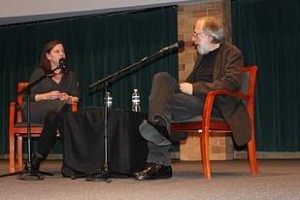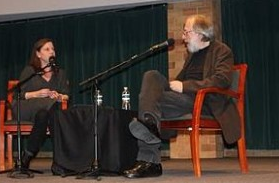Film critic Kenneth Turan talked about documentaries and 3-D movies, the movie theater experience and foreign Westerns Thursday night in the O’Shaughnessy Educational Center Auditorium.
Turan, who works for the Los Angeles Times and National Public Radio, shared his opinions with students, local movie buffs and MPR’s Stephanie Curtis as part of the Minnesota Broadcast Journalist Series.

“I want to spread the good news about good films,” Turan said. “I try to avoid dreadful films. Life’s too short.”
Turan was generally positive, but his audience still left the auditorium with a list of films to avoid.
“I really had no use for ‘Black Swan,’” Turan said. “I thought it was high-art trash.”
Turan said his picks for best movie of 2010 included “Inception,” “The Social Network” and “Toy Story 3.”
“Hollywood has given up on us,” Turan said, gesturing to his audience. “It’s rare to have three major studio films that are intelligent.”
Turan said he wishes more studios would produce Western films. He said there are many interesting Western films he’s seen over the years, including Westerns made by East Germans during the Cold War that were filmed in Croatia.
Emergence of 3-D
Curtis asked Turan his opinion on 3-D movies, and he made it clear “Avatar” is in a dimension of its own.
“When you see ‘Avatar’ in 3-D you see something special,” Turan said. “That’s why that film made so much money. What Hollywood said is ‘Oh, we can do this quick and dirty and make a lot of money.'”
Turan said films such as “Clash of the Titans” have 3-D effects added as an afterthought, and the result is ugly.
“Quick and dirty is wearing off,” Turan said. “People aren’t interested in paying more money for something that isn’t that good.”
Audience member and screenwriter Mark Mikula said he appreciates filmmakers who try to do 3-D.
“The care and the craft that Cameron put into [‘Avatar’] is really helpful for exploring how much there could be with that technology,” Mikula said.
Movie fan George Bigelow sees 3-D as a step in technology that may lead to holographic movies.
“At first you had to have it black and white and then color came in,” Bigelow said. “It’s like another jump in technology.”
Value of theaters
Curtis described her experience seeing “Arthur” in theaters to illustrate how theaters may be hurting their own cause. She expected the movie’s soundtrack to be “raucous,” but the speakers were out and nobody did anything about it.
“The theatrical experience is not what it once was,” Turan said. “I think theater owners are aware that they are part of the problem, so the more progressive ones are trying to change that.”
When Curtis asked Turan to define the value of the theater experience, he took it as a rhetorical question, but Bigelow had some opinions about what makes the experience unique.
“The communal experience is the most important part about the film,” Bigelow said. “You can’t really share something sitting at home by yourself.”
Turan said everyone who values the theater experience should attend theaters often, because the experience won’t be around forever.
“It will disappear,” Bigelow said. “It’s just too easy with Netflix and stuff like that. It’s going so fast.”
Near the end of the discussion, Turan told his audience not to miss two movies: “The Tree of Life” starring Brad Pitt and Sean Penn and the British movie “Submarine.”
Alex Keil can be reached at amkeil@stthomas.edu.



